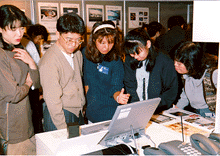
Computers and other high-tech instruments are not the only
user-friendly goods on the market. A myriad of user-friendly
appliances, toys, and even shampoos have also made their
appearance. Although originally designed for handicapped and
elderly people, these goods have proved extremely popular
among all consumers, and the concept of user-friendly is
well on its way to becoming a given in product design and
development.
Trailblazing Toiletries
The first user-friendly products to hit the market were a
shampoo and rinse. Taking into account remarks from
customers that it is difficult for people with good eyesight
and virtually impossible for those who are nearsighted,
farsighted, or have other visual impairments to distinguish
between a bottle of shampoo and rinse when washing their
hair, one manufacturer in the fall of 1991 marketed a
shampoo bottle with raised marks on its side so that people
could distinguish it from a rinse bottle just by touch. The
company urged its competitors to follow suit, and today the
mark has become standard practice among shampoo makers.
User-friendly innovations do not just benefit people with
handicaps or the elderly but all consumers. For example, a
recently developed vending machine features conveniently
placed buckets for receiving the product and change in the
middle of the machine, at the level of a person's waist,
rather than near the bottom of the machine, as was
previously the case. In addition, the slot for inserting
money has been enlarged.
According to the manufacturer, sales at these machines
are 60-percent higher than at conventional ones, indicating
that they are luring not only the disabled and elderly but
other customers as well.
Company- and industry-wide moves
Entire companies have thrown themselves into the task of
creating user-friendly goods. In 1995 one electric appliance
maker that had been providing braille labels for the control
buttons on its dual-function toilet-bidets, washing machines
and dryers, and electric carpets began affixing labels to
all its cookware operated by electromagnetic induction.
Though previously it had sent braille stickers for the
cookware to those who requested it, it devised a system for
adding braille in the production process.
The company says that braille is just the first step
and that it ultimately plans to vary the shape of the
buttons and come up with other innovations so that anybody
can identify them by touch.
Meanwhile, the toy industry has been providing an
industry-wide response to the concept of user-friendly.
Products that meet certain criteria for being accessible to
children with visual impairments now carry a seeing-eye-dog
mark. First, the power button must move to a raised or
lowered position so that children can tell whether it is on
or off by touch. And the battery compartment cover must also
be easily removable as well as identifiable by touch. As of
October 1995, 183 products of 27 companies carried the
seeing-eye-dog mark.
Innovations will likely be introduced with prepaid
cards for telephones, public transportation, and shopping so
that users know which way to insert the card in the machine.
Japan Industrial Standards rules will probably be revised so
that all telephone cards contain a semicircular notch,
transportation cards a triangular notch, and shopping cards
a rectangular notch.
(The above article, edited by Japan Echo Inc., is based on domestic Japanese news sources. It is offered for reference purposes and does not necessarily represent the policy or views of the Japanese Government.)